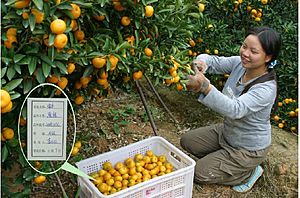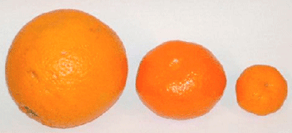Kishu mikan facts for kids
The kishu mikan is a special type of mandarin orange. It's a hybrid, meaning it's a mix of different citrus fruits. You can find it growing in Southern China and Japan.
This tiny fruit is also called Baby Mandarin, Tiny Tangerine, or Mini Mandarin. In Europe, it's sometimes sold as "Cherry orange." Kishu mikans are shaped like regular mandarins but are much smaller, usually about 2.5 to 5 centimeters wide. They have a thin, smooth orange skin.
Some types of kishu mikans, like the mukakukishu, don't have any seeds! This makes them great for snacking. The largest type is called hirakishu.
Contents
A Long History

The kishu mikan is believed to have started growing in Southern China around the 700s. Its name was even written down in records during the Ming dynasty. It became very popular in the Jiangxi province of China.
Around the year 1200, this fruit was brought to Japan. It quickly became the most popular citrus fruit in Tokyo and stayed that way until the 1800s.
Kishu Mikans in America
Kishu mikans first arrived in America in the 1800s. However, they weren't very well known at first.
In 1983, scientists at the University of California Citrus Research Center started working on a seedless version. This helped the fruit become popular for selling in stores. Kishu mikans began to be grown commercially in the United States in the 1990s. By around 2010, they were widely grown across the country.
The fruit also became available in Europe starting in 2006.
What Does It Taste Like?
Kishu mikans are known for being very sweet. Like other mandarins, they are also packed with Vitamin C, which is good for your health.
The fruit has a very thin skin, about 0.11 centimeters thick. Inside, you'll find 7 to 19 juicy sections. As mentioned, some varieties are seedless, while others have a few seeds.
How Kishu Mikan Trees Grow
Kishu mikan trees are evergreen, meaning they stay green all year. They are small trees, usually growing less than 1.3 meters wide and 3.3 meters tall. These trees can live for hundreds of years!
They are a favorite plant for gardens in Japan. People also grow them in greenhouses or on balconies. Of course, they are also grown in large orchards for commercial sales.
Caring for the Trees
Kishu mikan trees need about five hours of sunlight every day. They prefer temperatures between 13 and 24 degrees Celsius (55 and 75 degrees Fahrenheit). If they are in pots, you can bring them inside at night if it gets too cold.
These trees like high humidity, but their soil must drain well. Sometimes, people carefully move pollen between the blossoms by hand. This can help the trees produce more fruit.
The fruit grows to be about 2.5 to 5 centimeters in size. It is usually harvested in the middle of winter, from November to February, depending on the local weather. If the fruit stays on the tree for too long, it can lose its flavor.
Kishu mikan trees can start producing fruit in their very first year. They typically yield about 40 kilograms (88 pounds) of fruit each year. The fruit needs to be handled gently to avoid damaging its thin skin.



